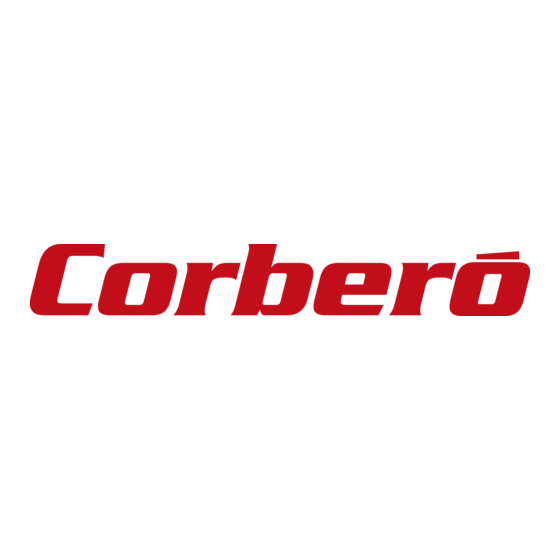
Summary of Contents for CORBERO LC2850
- Page 1 MANUAL DE INSTRUCCIONES - INSTRUCTION BOOKLET Lavadora Washing machine LC 2850 132995481...
-
Page 2: Table Of Contents
Dear customer, Transport damages Please read these operating instructions carefully and When unpacking the appliance, check that it is not pay particular attention to the safety notes indicated in damaged. If in doubt, do not use it and contact the the first pages. -
Page 3: Warnings
Warnings The following warnings are provided in the interests of overall safety. You must read them carefully before installing or using the appliance. Installation • Leave the porthole door slightly ajar when the appliance is not in use. This preserves the door seal •... -
Page 4: Disposal
Disposal Packaging materials Machine The materials marked with the symbol are recy- Use authorised disposal sites for your old appliance. clable. Help to keep your country tidy! >PE<=polyethylene >PS<=polystyrene >PP<=polypropylene This means that they can be recycled by disposing of them properly in appropriate collection containers. -
Page 5: Installation
Installation Unpacking 6. Plug all the holes with the plugs which you will find in the envelope containing the instruction booklet. All transit bolts and packing must be removed before using the appliance. You are advised to keep all transit devices so that they can be refitted if the machine ever has to be transport- ed again. -
Page 6: Water Drainage
Electrical connection Water drainage The end of the drain hose can be positioned in three This machine is designed to operate on a 220-230 V, ways: single-phase, 50 Hz supply. Check that your domestic electrical installation can take the maximum load required (2.2 kW), also taking into account any other appliances in use. -
Page 7: Door Reversal
Door reversal The opening direction of the outer door on this wash- ing machine can be reversed. To carry out this op- eration, proceed as follows: 1) Disengage the end of the opening stop (1) from the door and turn it through 90° to remove it from its seat (Fig. -
Page 8: Use
Control panel 5 Half load button (ECO-AHORRO) 1 Detergent dispenser drawer Select this button to reduce water consumption on the Symbols rinse cycle when washing a smaller load of cottons or Prewash linens. (Maximum load size = 2.25 kg). Wash Fabric softener 6 Anti-crease button (ANTI-ARRUGAS) Bleach... -
Page 9: Washing Hints
Washing hints Sorting the laundry synthetics: drum no more than half full; delicate fabrics and woollens: drum no more than Follow the wash code symbols on each garment label one third full. and the manufacturer’s washing instructions. Washing a maximum load makes the most efficient Sort the laundry as follows: use of water and energy. -
Page 10: Detergents And Additives
Quantity of detergent to be used Lipstick: moisten with acetone as above, then treat stains with methylated spirits. Remove any residual The type and quantity of detergent will depend on the marks from white fabrics with bleach. type of fabric, load size, degree of soiling and hard- Red wine: soak in water and detergent, rinse and ness of the water used. -
Page 11: Washing Programmes
Programme table WASHING PROGRAMMES FOR COTTONS AND LINEN Max. load: 4.5 kg Possible Temp. Programme Cycle description options Prewash Whites with prewash HALF LOAD Wash at 60°-90°C 60°-90° Rinses (Blanco muy sucio + prelavado) SPIN SELECTION Spin Whites 60°-90° Wash at 50°-90°C (Blanco sucio sin prelavado) HALF LOAD Rinses... - Page 12 Programme table WASHING PROGRAMMES FOR SYNTHETICS, MIXED FIBRES, DELICATES AND WOOLLENS Maximum load: 2 kg, woollens: 1 kg Possible Temp. Type of laundry Cycle description options Prewash Synthetics with prewash RINSE HOLD Wash at 30°-60°C Heavy soiled 30°-60° Rinses SPIN SELECTION (Muy sucio + prelavado) Short spin (*) Synthetics without prewash...
-
Page 13: International Wash Code Symbols
International wash code symbols These symbols appear on fabric labels, in order to help you choose the best way to treat your laundry. Energetic wash Max. wash Max. wash Max. wash Max. wash temperature temperature temperature temperature 95°C 60°C 40°C 30°C Hand wash Do not... -
Page 14: Operating Sequence
Operating sequence 4 Select the required option and the spin speed Important: Before washing your first load of laundry, we recom- mend that you run a cotton cycle at 60°C, with the machine empty, in order to remove any manufactur- ing residue from the drum and tub. -
Page 15: Maintenance
Maintenance 1. Bodywork Place a container under the filter and unscrew it. Clean the outside of the machine with warm water and a neutral, non-abrasive household detergent. Rinse with clean water and dry with a soft cloth. Important: do not use methylated spirits, solvents or similar products to clean the bodywork. -
Page 16: Emergency Emptying Out
5. Emergency emptying out If the water is not discharged (outlet pump is blocked, filter or drain hose are clogged), proceed as follows to empty out the machine: • pull out the plug from the power socket; • close the water tap; •... -
Page 17: Something Not Working
Something not working? If you are unable to identify or solve the problem, If the machine does not start up: consult our servicing department. Before telephoning, check that the door is firmly shut; ● make a note of the make, model and date of purchase check that the appliance is plugged in ●...






Need help?
Do you have a question about the LC2850 and is the answer not in the manual?
Questions and answers